Master this critical step to perfect the blind retrieve.
By James B. Spencer
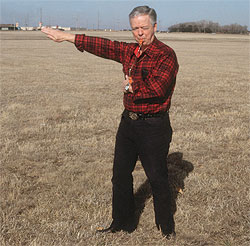 A right-arm Over cast. |
This is the fourth and final installment of this series on the blind retrieve. The June/July column presented an overview; the August column covered lining; the September column covered stopping, so, not surprisingly, this column covers casting. (Nota bene: To focus on the handler's job in casting, I must assume that the dog is already trained. For information on how to train a retriever to take casts, see my books, Training Retrievers for Marshes & Meadows, and Retriever Training Drills for Blind Retrieves, which are available from the Gun Dog Bookshelf.)
Get His Attention
Okay, you've stopped your distant pooch with the Sit-whistle, intending to redirect him with a cast. Trouble is, he may have already made up his mind where he should go next.
He may not even be looking at you. If he's looking elsewhere, he won't see your cast, but on hearing your command (Back, Over, or Come-whistle), he'll take off in his pre-selected direction, which will seldom be what you have in mind.
Even if he seems to be looking at you, he may not be paying attention, so he will go his way, not yours, when you cast him. You need to know your dog well enough to know when you have his attention and when he's in his own little world out there.
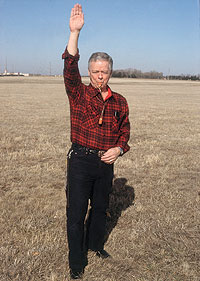 A right-arm Back cast. |
If you have doubts about the "locus of his focus," toot the Sit-whistle again -- and again if necessary -- to remind him that you're the quarterback on this team. If he's on land, you can wait a few seconds for him to make eye-contact with you. If he's in water, you can't expect him to tread water while you glare at him, so you should either cast him or toot the Sit-whistle again.
If a couple of Sit-whistles don't bring him around, blow the Come-whistle to start him moving toward you. Then, when he's coming toward you and looking at you, toot the Sit-whistle again. This will almost always induce him to give you his undivided attention.
Which Cast?
Dave Elliot, the inventor of the blind retrieve, offered only four very basic casts: straight Back, Over to the left, Over to the right, and straight Come-in. However, since then, retrieverites have developed many other casts, mostly to gain a competitive advantage in field trials.
First, they added four angled casts, each about half-way between adjacent pairs of the four basic casts. Then they created several increasingly esoteric casts, some involving such "whole person" body language that a field trial handler at the line sometimes appears to be doing some sort of ritual dance.
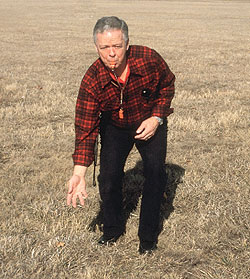 A right-arm Come-in cast. |
If you are not a field trialer trying to beat the competition by picking up the meat with the fewest whistles (casts), you don't need any cast beyond Mr. Elliot's basic four. Of course, if you enjoy teaching the more advanced casts, wonderful. Enjoy. But you can get by without them.
A duck or pheasant will be equally tasty whether your dog picks it up with a basic Over followed by a basic Back or with a precise angled Back. Therefore, here I'll cover only the four basic casts: Back, Over (either direction), and Come-in.
Back!
You should normally change arms when going from an Over to a Back. If your dog is on, say, a left-arm Over when you stop him, you should give the Back with your right arm, and vice versa. If you use the same arm for the Back as you did for the preceding Over, your dog will very likely continue the Over, or take a shallow angled Back in the direction of the previous Over. Why? Beats me, but retrievers just seem to behave that way.
You need to be aware of which way your dog turns when starting out on a Back. Some dogs always turn to the handler's left; others always to the handler's right. Of course, many trainers take the time to train their dogs to "turn with the arm," that is, to turn to the handler's right on a right-arm Back and to the handler's left on a left-arm Back. This is the ideal situation, but it does take special training.
You also need to know how big a loop your dog makes in going back. Some dogs spin around almost on a dime; others simulate a scat-back on an end-around, swinging out wide to the side before racing down the sideline.
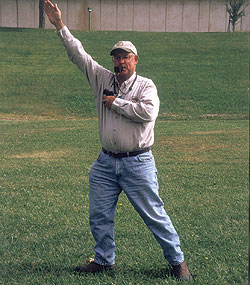 A left-arm angled Back cast. Not necessary, but sometimes handy. |
Let's say your dog always loops wide to your right. In some situations, that will put him in big trouble. For example, it could put him into some dense woods where you and he wouldn't be able to see each other. Such a situation calls for handler ingenuity to keep the dog out of trouble.
For example, you might give him a left-arm Over to carry him far enough away from the woods so he won't reach it when he loops around on the subsequent Back. You might also keep him out of trouble with a "hard" left-arm Over (see below).
Of course, if you would train him to turn with your arm, you could direct him away from the trouble area by using the opposite arm for the Back. With trouble on the right, give him a left-arm Back, and vice versa.
Over
You can give an Over cast in three ways: normal, "hard," and "soft." Your dog will react differently to each of the three, instinctively.
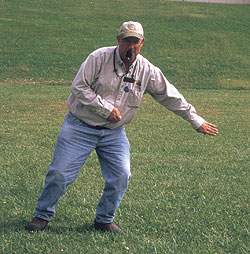 A right-arm angled Come-in cast. Again, not necessary, but sometimes handy. |
You give a normal Over just as you give them when teaching your dog to take your casts.
You say "Over" in a normal tone of voice as you pump your arm leisurely in the desired direction and move casually to that side. You should use this normal Over in ordinary circumstances, that is, whenever you want your dog to go straight left or right and are reasonably confident he'll do so.
You give a hard Over by bellowing "Over!" as you pump your arm vigorously in the desired direction and move rapidly to that side. When you give a hard Over, your dog will instinctively scallop to the rear after taking your cast for only a short distance.
Sometimes this is exactly what you need to put your dog on the bird, or to keep him out of trouble that a Back cast might put him into. (For example, in the situation described above about a dog that always loops wide to the right on a Back cast.)
You give a soft Over by saying "Over" softly (or not at all) as you pump your arm gently in the desired direction and move slowly to that side. You should use the soft Over whenever you sense your dog is apt to scallop back on a normal Over -- for example, when he has just scalloped back on a normal Over and you've stopped him again. This time you should use a soft Over because you're sure he would again scallop back on a normal Over. As you get to know your dog, you'll learn when to anticipate the need for a soft Over.
Here's an example of when you should give the soft Over first rather than a normal Over.
Your dog is running down a shoreline when he should be angling into the water. You stop him. If you give him a normal Over, the odds are about ten to one that he'll scallop back and continue running down the shoreline. So you give him a soft Over. This will usually work, but sometimes your dog will still scallop back. If he does, what should you do?
Surprise the hell out of him!
How? With a trick cast. First, stop him again. Then give him another soft Over, but this time, instead of saying "Over," blow the Come-whistle invitingly. That whistle will definitely wipe all thought of scalloping back off of his mental slate, allowing him to focus completely on what your arm signal and body movement are telling him to do.
Nota bene: Use this gimmick rarely and only in very critical hunting or dog-game situations. If you use it often, or in training, it will lose its element of surprise and hence its effectiveness.)
Come-Whistle
This cast lacks the complications of Back and Over. Simply toot the Come-whistle and remain motionless. Oh, sure, if you prefer (as most seem to), you can squat a bit and drop one hand straight down so you knuckles almost touch the ground between your feet.
Either way, your pooch will catch your drift and move appropriately.
Nota Bene: Jim Spencer's books can be ordered from the Gun Dog Bookshelf: Training Retrievers for Marshes & Meadows; Retriever Training Tests; Retriever Training Drills for Marking; Retriever Training Drills for Blind Retrieves; Retriever Hunt Tests; HUP! Training Flushing Spaniels the American Way; and POINT! Training the All-Seasons Bird Dog.






